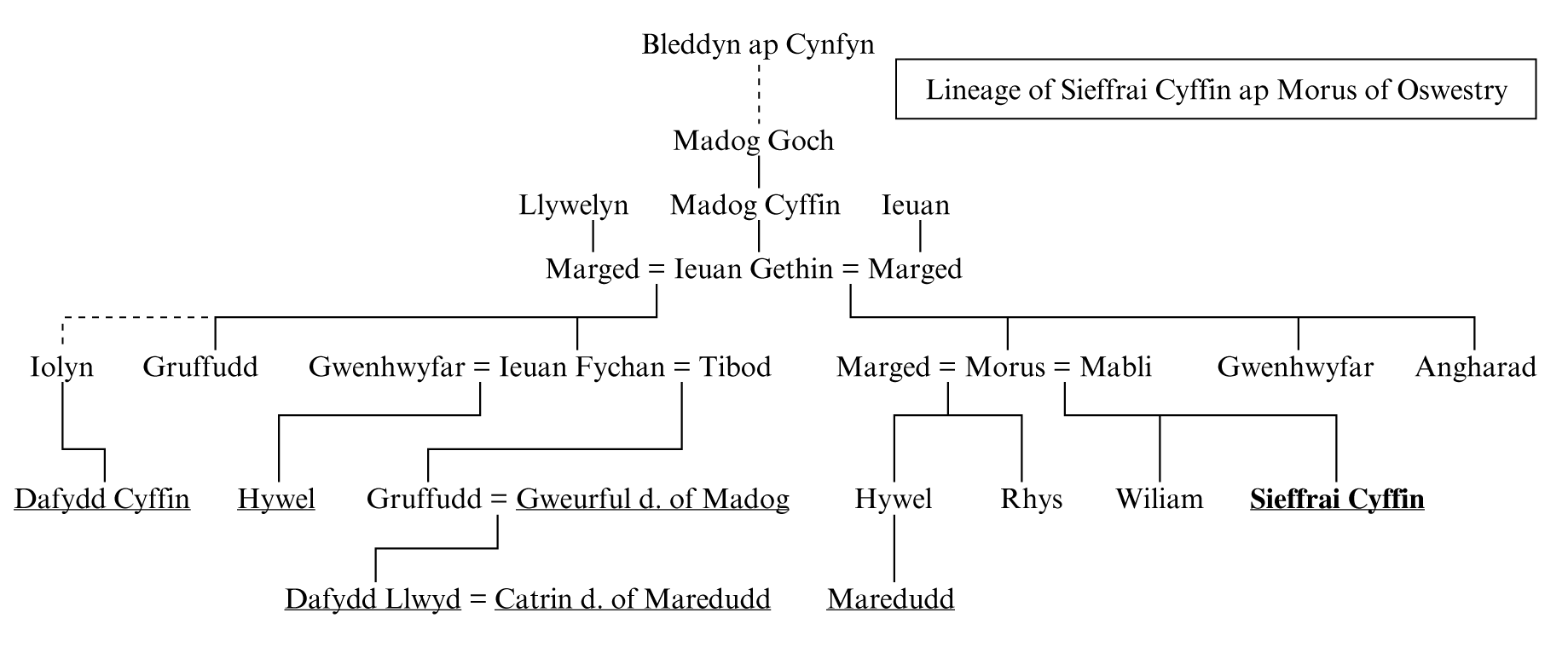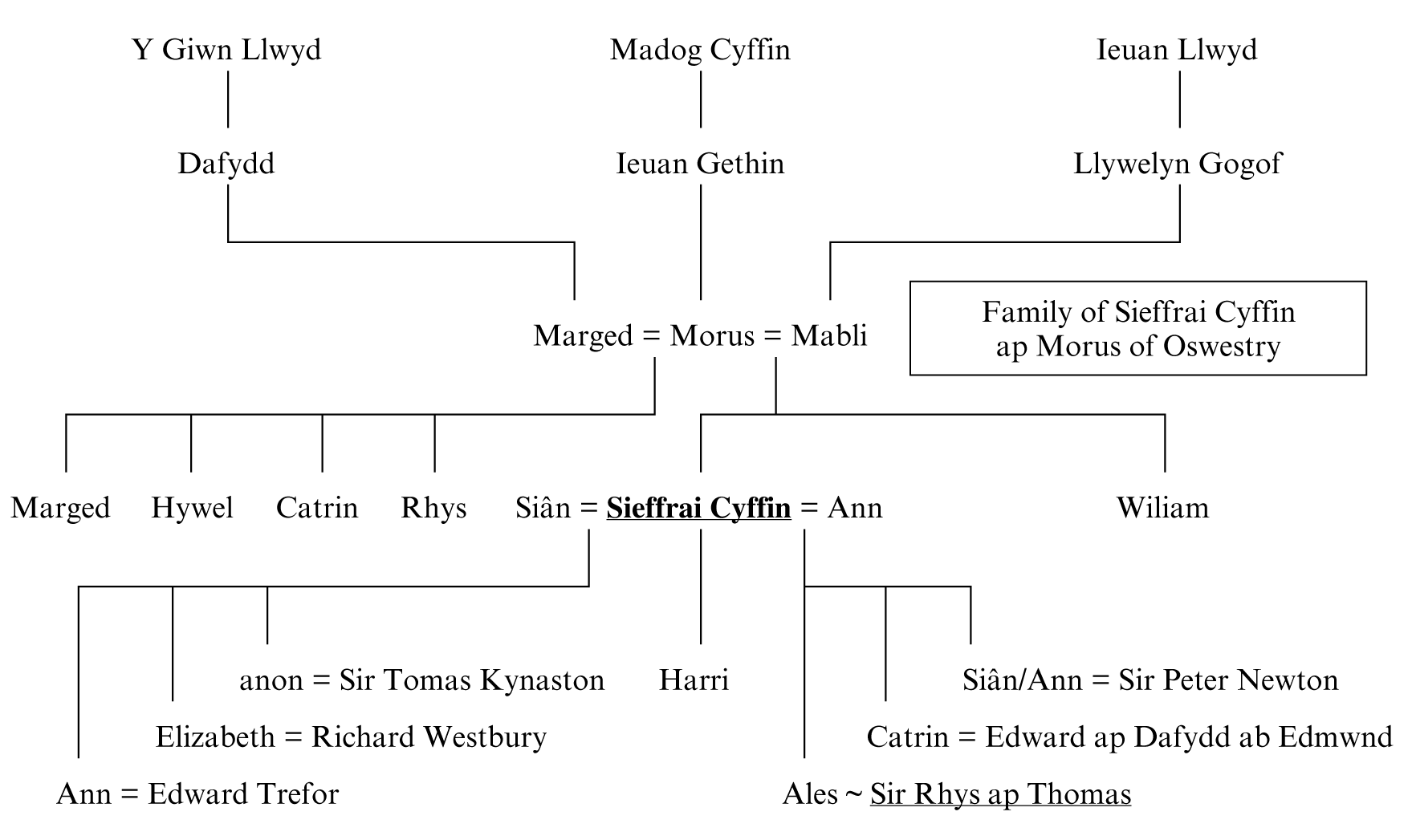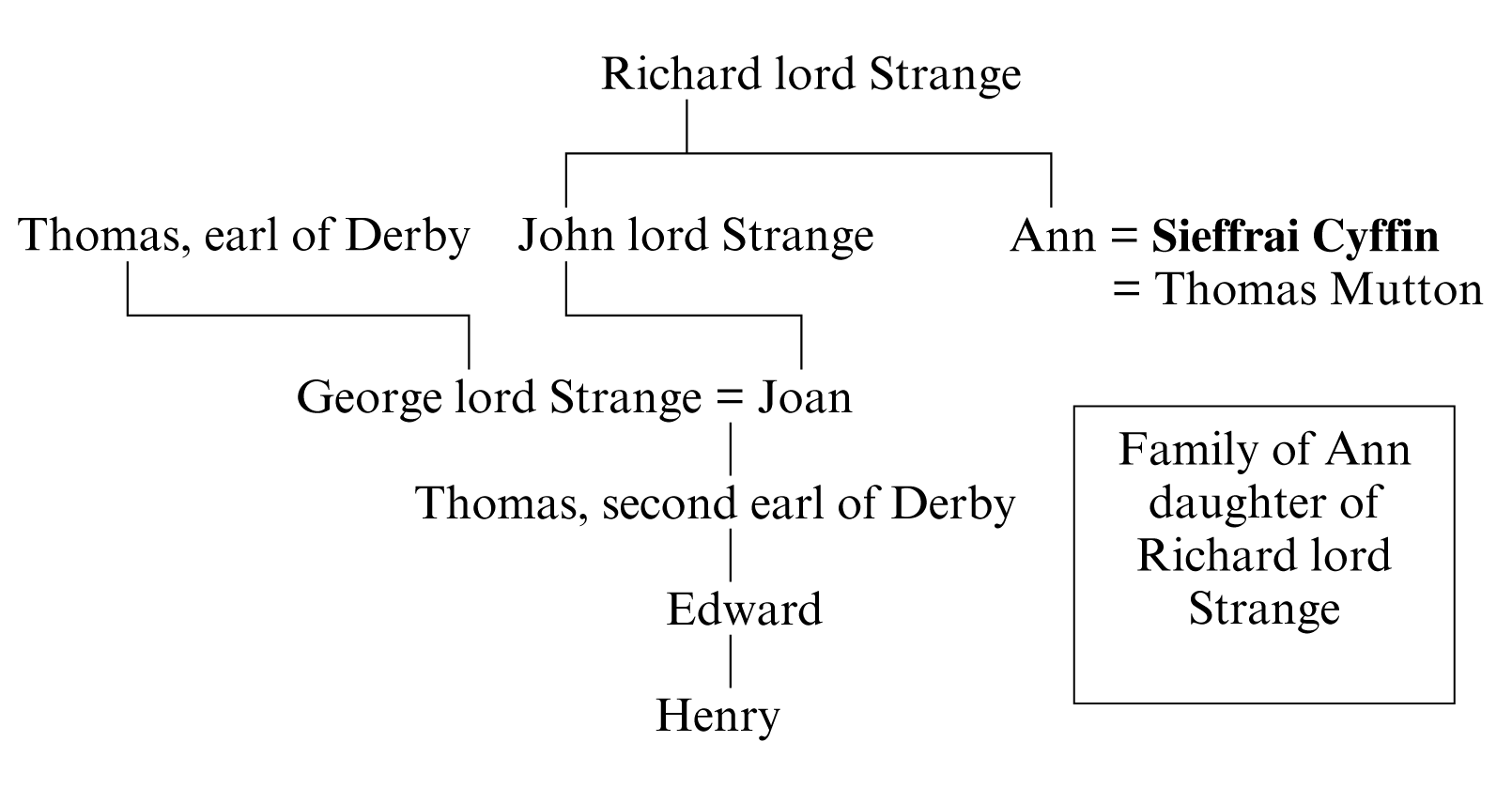Sieffrai (or Geoffrey) Cyffin was one of Guto’s most important patrons in the March. Although it is likely that Sieffrai was a patron of many poets, only Guto’s five poems to him have survived:
- a poem of praise (poem 96);
- a poem of praise for both Sieffrai and his wife, Siân daughter of Lawrence Stanstry (poem 97);
- a poem to request a brigandine on behalf of Dafydd Llwyd of Abertanad (poem 98);
- a poem to request a hunting horn on behalf of Siôn Eutun of Parc Eutun (poem 99);
- a poem to request a pair of greyhounds on Sieffrai’s behalf from Rhobert ab Ieuan Fychan of Coetmor (poem 100).
Tudur Aled composed a poem of praise for Edward Trefor and his wife, Ann Cyffin, Sieffrai’s daughter (TA poem 51 and especially lines 43–56). Lewys Cyffin ap Siôn, grandson of Sieffrai’s brother, was praised by Huw ap Dafydd (GHD poem 20) and Wiliam Llŷn composed his elegy (Stephens 1983: 327; not included in WLl).
A distinction should be made between Sieffrai Cyffin and another man of the same name who was abbot of Aberconwy during the first half of the sixteenth century (Williams 1970–2: 188, 196; idem 2001: 295). Tudur Aled praised this Abbot Sieffrai Cyffin (TA poem 27). Lowe (1927: 272) claims that ‘Geoffrey Kyffin’ was abbot of Aberconwy in 1450, likely an error for 1550.
Lineage
The genealogical table below is based on WG1 ‘Bleddyn ac Cynfyn’ 9, 10, 11; WG2 ‘Bleddyn ap Cynfyn’ 10 F2, 11 A3. The names of Guto’s patrons are underlined.

Lineage of Sieffrai Cyffin ap Morus of Oswestry
As is shown, Sieffrai was a half-uncle of Maredudd ap Hywel of Oswestry and a half-cousin of both Dafydd Cyffin ab Iolyn of Llangedwyn and Hywel ab Ieuan Fychan of Moeliwrch. He was also a half-cousin of Gruffudd ap Ieuan Fychan of Abertanad, husband of Gweurful daughter of Madog and father of Dafydd Llwyd. Furthermore, Sieffrai was distantly related to both Siôn Eutun of Parc Eutun and Rhobert ab Ieuan Fychan of Coetmor.
The genealogical table below shows Sieffrai’s immediate family. It is based on WG1 ‘Bleddyn ap Cynfyn’ 9, 11, 27, ‘Seisyll’ 2, WG2 ‘Bleddyn ap Cynfyn’ 11D and on information in the hand of John Davies of Rhiwlas (1652–c.1718) in LlGC 8497B, 66r–67r beside a copy of poem 97 in the hand of Thomas Wiliems.

Family of Sieffrai Cyffin ap Morus of Oswestry
John Davies tells us of Catrin daughter of Sieffrai’s marriage to one Edward ap Dafydd ab Edmwnd, y pencerdd o blwy hanmer ‘the chief poet from the parish of Hanmer’. The poet Dafydd ab Edmwnd’s son is not mentioned in the genealogies, only a daughter, Marged, yet his name may have been unfamiliar to scribes due to the fact that he had no issue (bu iddynt ddim plant; WG1 ‘Hanmer’ 2; note that one Hopgyn ap Dafydd ab Edmwnd is named in ibid. ‘Trahaearn Goch of Llŷn’ 2). Davies also notes that one unnamed daughter of Sieffrai who married Sir Tomas Kynaston died yn ddi blant ‘childless’. Another daughter, Ann, married Edward Trefor ap Siôn Trefor, constable castell y drewen ‘constable of the castle of Whittington’ according to Davies. He also notes that Ales daughter of Sieffrai had a relationship with Sir Rhys ap Tomas of Abermarlais, and that she gave birth to a child out of wedlock. She had a daughter who died young (Griffiths 1993: 64, 270).
Sieffrai married twice, first with Siân (or Joan) daughter of Lawrence Stanstry (yr hon a elwyd y saesnes goch o gent ‘who was called the Red Englishwoman from Kent’ according to Davies) and then with Ann of the Strange family of Knockin. Gruffudd Hiraethog noted in Pen 176, 357 (c.1552), that Ann was the daughter of John lord Strange, and he wrote the same information originally in Pen 134, 380 (c.1550–8), before he changed his mind: Ann fh’ chwaer sion arglwydd ystraens ‘Ann, daughtersister of John lord Strange’. The amendment is supported twice by Wiliam Llŷn in Pen 139, i, 64–5 (c.1567–77), and although he noted on page 66 that Ann was John’s daughter, the information was amended (by Wiliam himself, in all likelihood) at a later date: nid gwir fry am blant argl’ straens chwaer oedd wraic sieffre kyffin i iohn y diweddaf or arglwydde straens ‘the above information about the children of lord Strange is incorrect; Sieffrai Cyffin’s wife was the sister of John the last lord Strange’. According to Wiliam, John, the last lord Strange by blood from Knockin, was succeeded by his daughter, Sian, who married George lord Stanley, son of the first earl of Derby. This information is supported in Kidd and Williamson (1990: P 1075), where it is noted that Joan (Siân) was John’s only daughter. The genealogical table below is based on ibid. and on the evidence of the manuscripts as amended.

Family of Ann daughter of Richard lord Strange
His family and career
Sieffrai was the grandson of Ieuan Gethin and was therefore related to an extended family that exerted substantial influence in the March to the west of Oswestry during the fifteenth century. It is likely that Guto’s association with this extended family (through patrons such as Hywel ab Ieuan Fychan) enabled him to receive patronage from Sieffrai in due course. Sieffrai’s surname was introduced by his great-grandfather, Madog Cyffin. Griffith (1998: 196) states that Madog adopted the surname from a place of the same name in Llangedwyn (see GPC 730 s.v. cyffin ‘border, limit’) in order to differentiate between himself and his father, Madog Goch. Sieffrai’s father, Morus ab Ieuan Gethin, was the justice of the commote of Mochnant Is-Rhaeadr during the 1390s and is mentioned in a record following the failure of the Owain Glyndŵr revolt (Huws 2007: 97–8, 117n77). He was alive and associated with Oswestry in 1445 (CPR 1441–6, 397–8). Guto notes that Morus travelled to the town of Arras in north-east France and to Prussia in Germany (96.25–6), possibly on a pilgrimage (see the note below on his son’s pilgrimage). On both Sieffrai’s and his family’s arms, see DWH ii: 93–4.
Guto received Sieffrai’s patronage before November 1465, for about the beginning of that month Dafydd Llwyd of Abertanad and his wife, Catrin, both died of the bubonic plague. Guto composed a poem to request a brigandine from Sieffrai on Dafydd’s behalf (poem 98) in which he refers to Sieffrai’s [c]wnstablaeth ‘constableship’ in Oswestry (98.16, 22). It is known that he was one of the town bailiffs in 1463 and owned land in the town on 29 September 1465 (Huws 2007: 122n93; DWH ii: 93). It cannot be proved that Sieffrai was constable of Oswestry as well as bailiff in 1463 nor that he was also constable in 1465, yet it is reasonable to presume that he was. Sir Rhys composed a satire on Guto when he was a burgess in Oswestry (poem 101a), a satire which Guto refers to in his poem of praise for both Sieffrai and his first wife, Siân (97.25–8). In his poem, Sir Rhys names Siôn ap Rhisiart, abbot of Valle Crucis, c.1455–c.1480. In Guto’s poem to request a brigandine from Sieffrai he refers to the bwrdeisiaid ‘burgesses’ who would suffer in the absence of Sieffrai’s constableship, and in the next lines the first person plural of the pronoun ein ‘our’ is used as he describes Sieffrai’s importance to the town (98.19–26). The strong suggestion is that Guto himself was a burgess when he composed his poem sometime before November 1465, and it is likely that Sir Rhys also composed his satire on Guto about the same time, when Siôn was abbot. It is highly likely, therefore, that Sieffrai can be located in Oswestry c.1460–5.
Guto’s poem for both Sieffrai and his first wife, Siân, has already been mentioned. In Pen 176, Gruffudd Hiraethog notes that Sieffrai married his second wife, Ann daughter of Richard lord Strange, in 1467, yet in Pen 134 he notes that it was Sir Peter Newton and Siân, the eldest daughter of Sieffrai and Ann, who were married in that year. Since it is unlikely that Gruffudd was recording dates willy-nilly, it is extremely unlikely that both marriages were held in the same year, but which is correct? Since Siân daughter of Sieffrai would have been at least ten years old before she married, following on the basis of the evidence of Pen 134 it follows that she would have been born before c.1457 and that her parents were therefore married by the middle of the 1450s. Guto’s poem for both Sieffrai and his first wife would then have to be dated before c.1457 and Guto made a burgess of Oswestry around the same time. Although not impossible, such a theory is highly unlikely in light of the fact that a later date is more likely based on the substantial evidence outlined above, as well as the fact that Guto often refers to himself in these poems as an old man (97.26; 101.20, 47–50; 101a.31–6, 40, 55, 60; 102.1–4, 7, 49–50). It is argued, therefore, that it was Sieffrai’s second marriage that was held in 1467, not his daughter’s, and that Guto’s poem for both Sieffrai and Siân must be dated before that date.
GGl 347 notes that Sieffrai died in 1509, but it was his daughter, Ann, who died in that year (Griffith 1998: 254; HPF iv: 84). He was alive on 11 March 1475 (Jones 1933: 93), when he witnessed a deed to release land in Gwernosbynt and was named as Seneschal of Chirkesland. Although the offices of constable and seneschal were very similar in some cases (ibid. xxxiii), the association with the lordship of Chirk strongly suggests that Sieffrai had by then relinquished the constableship in the lordship of Oswestry. It is likely that Sieffrai had left Oswestry by that year, possibly to follow a legal career in line with his second marriage to Ann daughter of Richard lord Strange. Ann’s brother, John lord Strange, was called to parliament from 1446 to 1472 (Kidd and Williamson 1990: P 1075).
According to Wiliam Llŷn in Pen 139, i, 64, following Sieffrai’s death, his second wife, Ann, married Sr’ tomas mytyn. In another note at the bottom of page 66 in the same manuscript, Rhys Cain (writing c.1604) refers to both Ann and Siân, her daughter by Sieffrai:
Ann mitton vcho a Ioan mrch ac et
Sieffrey kyffin oeddynt vyw yr ail
vlwyddyn o deyrnasiad hari 7
mae’r weithred gyda ni Ric Blodwell.
‘Ann Mutton mentioned above and Joan [Siân] daughter and heir
of Sieffrai Cyffin were alive in the second
year of the reign of Henry VII;
the deed is in our possession, Richard Blodwell.’
Rhys Cain’s unedited poem of praise for Richard Blodwell (Rhisiart Blodwel ap Siôn Blodwel) states that he was a man of note in Oswestry and was active in the work of rebuilding the castle (LlGC 11986B, 33). Since he and his wife, Marged, were descended from Madog Cyffin and lived in the borough, it is no surprise that he possessed a document involving Sieffrai’s family (WG1 ‘Bleddyn ap Cynfyn’ 9, 45; WG2 ‘Bleddyn ap Cynfyn’ 42G, 45B). It was written between 22 August 1486 and 21 August 1487, and it is fairly clear that Sieffrai was not alive then. He died, therefore, sometime between 1475 and 1486/7 (note that his half-brother, Hywel, died in 1481, see Pen 75, 5).
In his note above, Rhys Cain refers to Siân as et[ifedd] Sieffrey kyffin ‘heir of Sieffrai Cyffin’. Unlike his brothers, Sieffrai does not seem to have been succeeded by a male heir. The only son named in the genealogies is Harry (or Henry) Cyffin, and his mother’s identity is uncertain. He may well have been an illegitimate child, for he is not mentioned at all in Sieffrai’s genealogy in LlGC 8497B, 66r–67r (see above), although this may be because no suggestion is made in any manuscripts had he either married or had issue. It is possible that he, like his father, had died by 1486/7 and that he was either without heir or had not been recognised as his father’s heir. The genealogical manuscripts above in the hands of Gruffudd Hiraethog and Wiliam Llŷn show that Sieffrai’s genealogy was recorded chiefly through his daughters’ marriages (especially Siân, wife of Peter Newton).
His locale
According to both Bartrum’s genealogies and Huw ap Dafydd’s poem of praise for Lewys Cyffin, grandson of Sieffrai’s brother, Wiliam ap Morus, that branch of Morus’s family settled at Gartheryr near Llanrhaeadr-ym-Mochnant (GHD 20.8, 37). Sieffrai settled in Oswestry. He is the second burgess named in an extensive list of Oswestry burgesses commissioned by the town bailiffs in 1546, along with his son, Harry, and a number of his sons-in-law and members of his extended family (Oswestry Archives, OB/A12). It seems that the list is a selection of the town’s eminent burgesses between c.1450 and 1546 that was based on earlier similar lists. The genealogies show that a great many of these burgesses were related either by blood or marriage, and the list is a valuable record of the strong links established between both Welsh and English families of note in the Marches which formed the basis of Oswestry’s prosperity in this period. Guto’s name was also recorded on the list, as well as that of Tudur Aled (see notes to poem 102).
His pilgrimage
It is likely that Sieffrai went on a pilgrimage to both Rome and Jerusalem around the year 1460. Guto refers hastily to the journey at the beginning of his poem for both him and his wife, Siân, where he states that Sieffrai visited the church of St Peter in the Vatican City before journeying to the port of Jaffa in Israel and visiting the Church of the Holy Sepulchre in Jerusalem (97.1–10). It is highly likely that Guto referred to the same journey in another poem for Sieffrai. Although no mention is made of the pilgrimage, Guto states that Sieffrai journeyed across the channel to France and through Burgundy to Greece and Africa (96.27–30). By combining details from both poems it can be argued that Sieffrai travelled through Burgundy in order to cross the Alps. According to Olson (2008: 19–20), there were three main routes across the Alps in the Middle Ages. The fact that Lewys Glyn Cothi travelled on a pilgrimage to Rome by what is known as the ‘German way’ suggests that Sieffrai also crossed the Alps from the same direction. Lewys states that he travelled (possibly from Anglesey) to Brabant and Flanders and then down through the Rhine Valley to Burgundy, from whence he journeyed through Germany and Swabia (in south-west Germany today) to Lombardy in northern Italy (GLGC 90.11–16). As in the case of William Wey (1405/6–76; DNB Online s.n. William Wey), another pilgrim who journeyed to Rome and Jerusalem in 1458, it is unclear where exactly both Lewys and Sieffrai crossed the Alps, but it is possible that they travelled through either St Gotthard’s Pass (Olson 2008: 20), the Reschen Pass or another pass in modern-day western Austria (Davey 2010: 113).
William Wey’s detailed account of his travels sheds some light on what Sieffrai must have experienced about the same time, such as the length of the journey and dealings with native peoples in a variety of different countries. Like most medieval pilgrims to Jerusalem, Wey travelled to Venice in order to find a ship that would take him to the port of Jaffa. It seems that Sieffrai, like Wey, visited Rome first before going to Venice, where pilgrims would often have to wait for weeks or months for a ready ship and then for favourable winds to set sail. Pilgrim ships from Venice would cross the Mediterranean Sea and stop occasionally on islands such as Crete and Cyprus (cf. Guto’s reference to Greece) before arriving at Jaffa, from whence the pilgrims would travel to the city of Jerusalem. Unlike Wey, Sieffrai does not seem to have returned the same way, for he also visited Africa (Egypt, in all likelihood). He may have visited Alexandria on his way home or even journeyed to Mount Sinai. For a map of Wey’s journey, see Davey 2010: 20–1.
Bibliography
Davey, F. (2010), The Itineraries of William Wey (Oxford)
Griffith, J.E. (1998), Pedigrees of Anglesey and Carnarvonshire Families (third ed., Wrexham)
Griffiths, R.A. (1993), Sir Rhys ap Thomas and his Family (Cardiff)
Huws, B.O. (2007), ‘Ailadeiladu Bywyd ar ôl Gwrthryfel Glyndŵr: Tystiolaeth y Canu i Foelyrch’, Dwned, 13: 97–137
Jones, G.P. (1933), The Extent of Chirkland (1391–1393) (London)
Kidd, C. and Williamson, D. (1990) (eds.), Debrett’s Peerage and Baronetage (London)
Lowe, W.B. (1912), The Heart of Northern Wales (Llanfairfechan)
Olson, K.K. (2008), ‘ “Ar Ffordd Pedr a Phawl”: Welsh Pilgrimage and Travel to Rome, c.1200–c.1530’, WHR 24: 1–40
Stephens, Roy (1983), ‘Gwaith Wiliam Llŷn’ (Ph.D. Cymru [Aberystwyth])
Williams, D.H. (1970–2), ‘Fasti Cistercienses Cambrenses’, B xxiv: 181–229
Williams, D.H. (2001), The Welsh Cistercians (Leominster)





